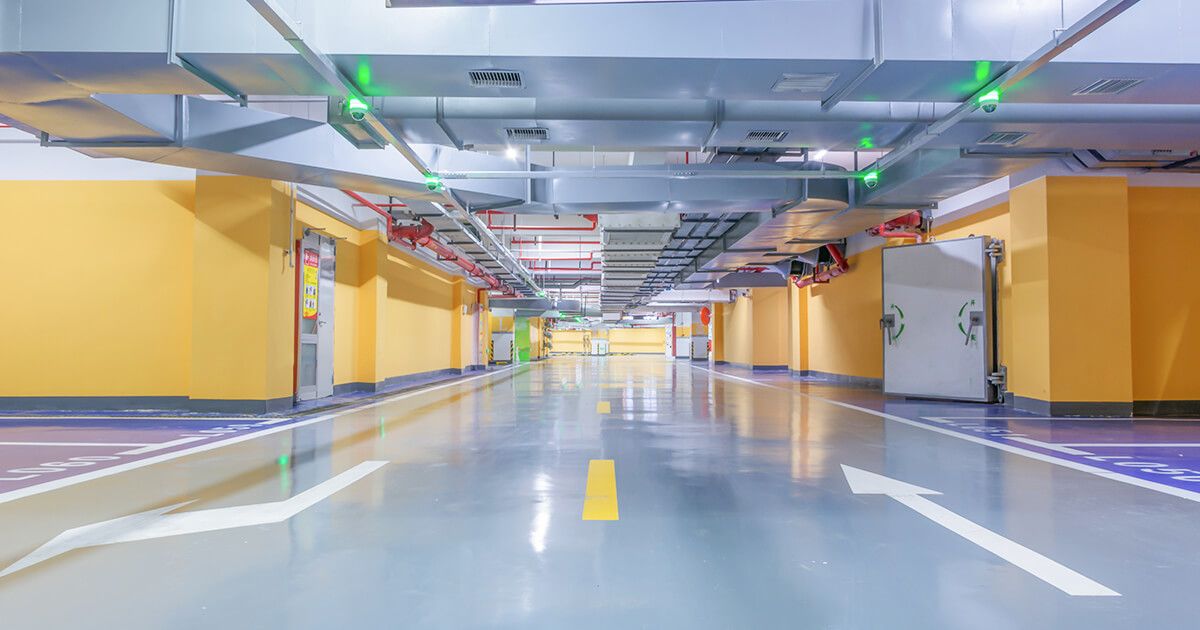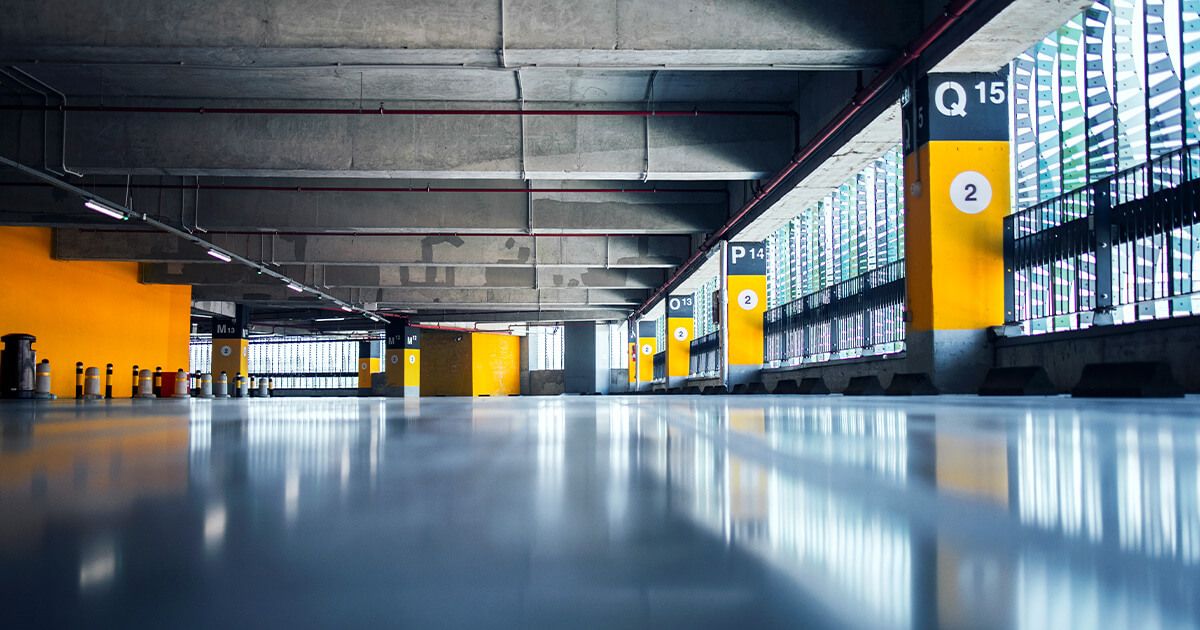
Concrete is an incredibly useful construction material – it can be used in a wide range of different applications. It is also quite strong and dependable, which is why concrete is often used for walkways, parking garages, and other areas that will see a high amount of traffic, both vehicular and pedestrian.
However, high-traffic areas are also at an increased risk of damage due to their exposure to various elements, including debris brought in from the traffic itself, the weather and other outdoor elements, as well as moisture. The damage, which includes deterioration like erosion as well as cracks, is precisely why many developers and building owners apply a traffic coating to protect these areas.
In this blog post, we will provide the detail you need to know about traffic coating, from the benefits it provides and when to use it, as well as the regulations surrounding its proper use.
At BNE, we improve the flooring experience. From placing and finishing the concrete through concrete surface preparation to epoxy floor and traffic coating, we have the knowledge, equipment, and skills to properly install the right type of flooring for any construction project. We leverage our position as an industry leader alongside cutting-edge technology to provide the client lasting flooring.
Our clients seek us out because we are a single source providing concrete finishing, concrete polishing and resinous flooring. This saves them time, money, and the hassle of communicating their needs to various contractors. Do not hesitate to reach out to us for your next construction project. We are just one phone call or email away!
What Are Traffic Coatings and Why Are They Important?
Traffic coatings are protective materials applied to surfaces like parking decks, bridges, and other structures to enhance their durability and longevity, particularly in environments exposed to heavy vehicular traffic and harsh weather conditions.
One of the most significant benefits and purposes of traffic coatings is to protect the reinforcing steel bars (rebar) embedded within the concrete from the intrusion of chloride ions, commonly found in the form of salt, which can be carried into the concrete by water runoff from vehicles. Here's a breakdown of this important function:
Corrosion Protection: Reinforcing steel bars (rebar) are commonly used within concrete structures to provide additional strength and structural integrity. However, steel is susceptible to corrosion when exposed to moisture and certain environmental elements. Chloride ions, such as those from salt, can accelerate the corrosion process when they penetrate the concrete and reach the rebar.
Salt Intrusion: In Canada, where roads are treated with de-icing salts during winter months or where there is exposure to saltwater environments (such as coastal areas), chloride ions from salt can easily find their way into the concrete through cracks, joints, and pores in the surface. This is a significant concern because it can lead to premature deterioration of the concrete and structural issues over time.
Traffic Coating as a Barrier: Traffic coatings act as a protective barrier on the concrete surface, preventing water, salt, and other harmful substances from infiltrating the concrete matrix. These coatings are typically applied in liquid form and can be elastomeric or polymeric in nature, providing a waterproof and chemically resistant layer.
Long-Term Durability: By effectively sealing the concrete surface and shielding the embedded rebar from chloride ion intrusion, traffic coatings play a vital role in extending the lifespan of the concrete structure. This, in turn, reduces maintenance and repair costs over the long term.
Safety: In addition to protecting the concrete and rebar, traffic coatings often have anti-slip properties to enhance safety for pedestrians and vehicles. They can also improve aesthetics and visibility by providing line striping and color options.
Environmental Considerations: Preventing chloride ion intrusion helps mitigate the environmental impact of concrete corrosion, as it reduces the need for frequent repairs and replacements, which can be resource-intensive.
Where Can Traffic Coatings be Used?
Here are some areas where traffic coatings are typically used and considerations related to their application:
Silane and Siloxanes
Used on slab-on-grade or below-grade applications. These coatings are often employed to protect concrete surfaces that are in contact with the ground or submerged below it.
Traffic Coatings
Traffic coatings are applied on suspended slabs or elevated concrete surfaces. Designed to withstand vehicular and pedestrian traffic, these coatings are suitable for structures like parking garages, bridges, and decks.
Waterproofing "Bathing Tub Effect"
It's crucial to ensure that the traffic coating extends up the walls and columns by 100-150mm. This creates a proper waterproofing "bathing tub effect", preventing moisture from infiltrating through joints or gaps between the horizontal and vertical surfaces.
Variation in Coating Thickness
Traffic coatings can be applied in different thicknesses depending on the specific application: Heavy application is often necessary for areas with ramps and turning radius due to increased wear and tear. In contrast, thinner applications may be suitable for parking stalls where the traffic load is not as concentrated.
Sloping for Proper Drainage
Sloping of concrete floors is critical even before applying traffic coatings. During the concrete pouring phase, it's essential to ensure that the concrete has adequate slope to allow for proper water drainage. Conducting pond testing by flooding the floor and verifying that water runs to designated drains is an important step before applying the traffic coating. Proper drainage ensures that water does not pool on the surface, which can lead to moisture-related issues and damage over time.
Types of Traffic Coatings
Here are details on a few of the different types of traffic coatings available:
Epoxy
Epoxy traffic coatings offer: increased slip resistance,
high durability (can withstand high amounts of traffic), and
pleasing aesthetics.
colour identification for traffic flow
This material is quite rigid as well.
Urethane
A top coating of urethane is a popular option for traffic coatings. As a material, urethane offers:
superior UV protection
improved chemical resistance
significant waterproofing,
slip resistance, and
significant protection (long lifespan).
This type of traffic coating does require maintenance, especially when it is exposed to heavy equipment like snow plows.
PMMA and PUMA
PMMA and PUMA refer to polymethyl methacrylate (PMMA) and polyurethane methacrylate respectively. These materials are:
quick drying (less downtime for high-traffic areas),
pungent (must be applied in well-ventilated areas),
can be applied at low temperatures,
must be applied to dry surfaces (for proper concrete adherence), and
require an exact mixture of chemicals.
Where A Traffic Coating Is Necessary
The installation of concrete in an outdoor or high traffic setting can often require a traffic coating. Some of the applications include:
parking garages,
stadiums and arenas,
walkways,
rooftop terraces,
footbridges,
parking decks and ramps, and
plaza decks.
Consultation with a professional is key to determining not only when a traffic coating is necessary, but also which type of coating would be most beneficial. However, common elements that are considered include whether the concrete will experience the following:
abrasion from heavy traffic,
oil and chemical spills,
water damage,
de-icing compounds and road salts in the winter, and
the degree of exposure to weather (rain, snow, even UV rays).
Each of the various types of traffic coating are suited to different situations – which is why these questions must be asked to zero in on what an individual project requires.

Benefits of Traffic Coatings
Now that we have a thorough understanding of precisely what a traffic coating is as well as the various types of coatings that are available, it is worth discussing exactly why applying a traffic coating is a good idea.
Here are details on the top 5 most common benefits of traffic coatings:
Waterproof
In climates that experience a significant amount of rainfall, or those otherwise exposed to high amounts of water, the waterproofing traffic coating can provide is essential. The coating forms a protective barrier between the water and the underlying concrete, which means the water cannot erode the concrete. Thus, the coating provides structural damage protection.
Increased Safety
Traffic coatings can provide an anti-slip surface with increased traction for the underlying layer. With the anti-slip coating, the risk of slips and falls dramatically decreases, which is particularly helpful from a safety perspective in unpredictable or inclement weather conditions. In addition, vehicular traffic coatings can also improve visibility for drivers as they offer sources of reflecting light.
Chemical Resistance
Traffic coatings in industrial areas and parking garages offer an unparalleled benefit: resistance to chemicals. Some of the common chemicals the coatings are primed to resist include oils and road salts. The coating means they cannot penetrate down to the layer of concrete underneath easily, extending the life of the roadway.
Easy To Maintain
Traffic coatings do not require a significant amount of maintenance, and when they do need it, the coatings are quite easy to maintain. As a result, they do not need repairs as frequently and when they do, they do not tend to cost as much.
Improved Aesthetics
Without traffic coatings, all of the roadways, walkways, and similar surfaces would look the same and quite boring at that. However, traffic coatings offer improved aesthetics since they come in a variety of colours, finishes, and other customizations.
Regulations for Traffic Coatings
Applying a traffic coating is not as simple as just picking one and applying wherever is suitable. There are several regulations surrounding traffic coatings that must be considered for not only proper application, but safety as well.
Here is the key information linked to the regulations for traffic coatings in Canada. Much of it stems from the Volatile Organic Compound Concentration Limits for Architectural Coatings Regulations, which apply to traffic coating:
manufacturers,
sellers,
importers, and
users.
Storage and Delivery
When it comes to the storage and delivery of traffic coating materials, there are 3 main regulatory elements. They are:
delivery in unopened and original containers,
storage of materials off the ground and protected from the elements (including heat, freezing temperatures, and rain) until they are needed for use, and
condition the materials as specified by the manufacturer.
It is also worth noting that the containers the traffic coating materials are delivered in must have the following information on it:
Manufacturer name
Product identification
Labels
Batch numbers
VOC Concentration Limits
Traffic marking (TM) coatings manufactured in Canada, or imported into the country, are subject to a VOC concentration limit. Specifically, traffic coatings must not contain more than 450 g/L of VOCs. It is forbidden to sell any coating that exceeds this limit.
Call A Traffic Coating Professional
When it comes to applying a concrete traffic coating, there are many reasons to do it. As discussed, these include:
waterproof;
protection against road salts, chemicals, and similar substances;
ease of maintenance; and
anti-slip surface providing increased safety to those walking or driving on it.
Ultimately, a quality traffic coating protects the investment of the concrete surface underneath. Thus, although there is an upfront investment associated with the application of a waterproof traffic coating, it will dramatically extend the concrete’s lifespan and save on costs in the long run.
At BNE, we improve the flooring experience. From concrete surface preparation and polished concrete to epoxy floor and traffic coating, we have the knowledge, equipment, and skills to properly install the right type of flooring for any construction project. We leverage our position as an industry leader alongside cutting-edge technology to provide the client lasting flooring.
Our clients seek us out because we are a single source providing concrete finishing, polish, and epoxy. This saves them time, money, and the hassle of communicating their needs to various contractors. Do not hesitate to reach out to us for your next construction project. We are just one phone call or email away!
